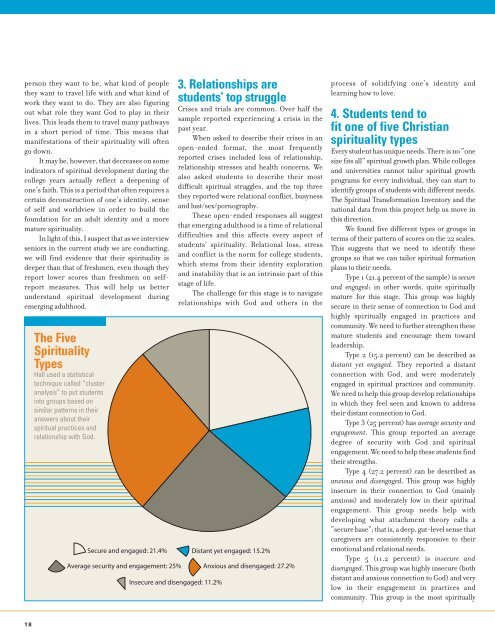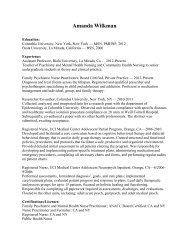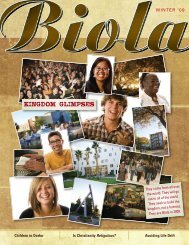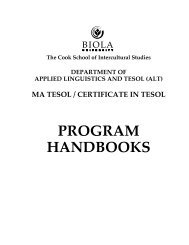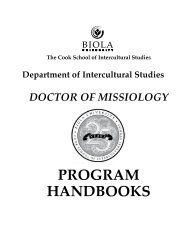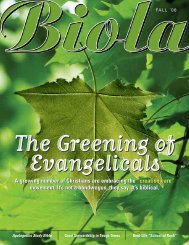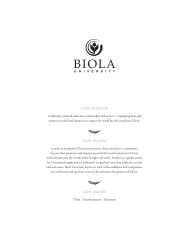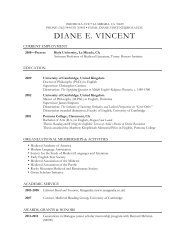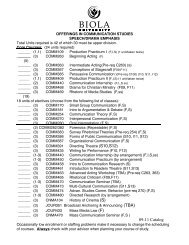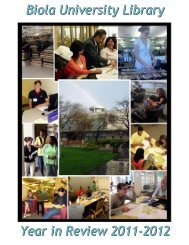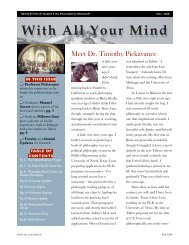You also want an ePaper? Increase the reach of your titles
YUMPU automatically turns print PDFs into web optimized ePapers that Google loves.
person they want to be, what kind of people<br />
they want to travel life with and what kind of<br />
work they want to do. They are also figuring<br />
out what role they want God to play in their<br />
lives. This leads them to travel many pathways<br />
in a short period of time. This means that<br />
manifestations of their spirituality will often<br />
go down.<br />
It may be, however, that decreases on some<br />
indicators of spiritual development during the<br />
college years actually reflect a deepening of<br />
one’s faith. This is a period that often requires a<br />
certain deconstruction of one’s identity, sense<br />
of self and worldview in order to build the<br />
foundation for an adult identity and a more<br />
mature spirituality.<br />
In light of this, I suspect that as we interview<br />
seniors in the current study we are conducting,<br />
we will find evidence that their spirituality is<br />
deeper than that of freshmen, even though they<br />
report lower scores than freshmen on selfreport<br />
measures. This will help us better<br />
understand spiritual development during<br />
emerging adulthood.<br />
The Five<br />
Spirituality<br />
Types<br />
Hall used a statistical<br />
technique called “cluster<br />
analysis” to put students<br />
into groups based on<br />
similar patterns in their<br />
answers about their<br />
spiritual practices and<br />
relationship with God.<br />
3. Relationships are<br />
students’ top struggle<br />
Crises and trials are common. Over half the<br />
sample reported experiencing a crisis in the<br />
past year.<br />
When asked to describe their crises in an<br />
open-ended format, the most frequently<br />
reported crises included loss of relationship,<br />
relationship stresses and health concerns. We<br />
also asked students to describe their most<br />
difficult spiritual struggles, and the top three<br />
they reported were relational conflict, busyness<br />
and lust/sex/pornography.<br />
These open-ended responses all suggest<br />
that emerging adulthood is a time of relational<br />
difficulties and this affects every aspect of<br />
students’ spirituality. Relational loss, stress<br />
and conflict is the norm for college students,<br />
which stems from their identity exploration<br />
and instability that is an intrinsic part of this<br />
stage of life.<br />
The challenge for this stage is to navigate<br />
relationships with God and others in the<br />
process of solidifying one’s identity and<br />
learning how to love.<br />
4. Students tend to<br />
fit one of five Christian<br />
spirituality types<br />
Every student has unique needs. There is no “one<br />
size fits all” spiritual growth plan. While colleges<br />
and universities cannot tailor spiritual growth<br />
programs for every individual, they can start to<br />
identify groups of students with different needs.<br />
The Spiritual Transformation Inventory and the<br />
national data from this project help us move in<br />
this direction.<br />
We found five different types or groups in<br />
terms of their pattern of scores on the 22 scales.<br />
This suggests that we need to identify these<br />
groups so that we can tailor spiritual formation<br />
plans to their needs.<br />
Type 1 (21.4 percent of the sample) is secure<br />
and engaged; in other words, quite spiritually<br />
mature for this stage. This group was highly<br />
secure in their sense of connection to God and<br />
highly spiritually engaged in practices and<br />
community. We need to further strengthen these<br />
mature students and encourage them toward<br />
leadership.<br />
Type 2 (15.2 percent) can be described as<br />
distant yet engaged. They reported a distant<br />
connection with God, and were moderately<br />
engaged in spiritual practices and community.<br />
We need to help this group develop relationships<br />
in which they feel seen and known to address<br />
their distant connection to God.<br />
Type 3 (25 percent) has average security and<br />
engagement. This group reported an average<br />
degree of security with God and spiritual<br />
engagement. We need to help these students find<br />
their strengths.<br />
Type 4 (27.2 percent) can be described as<br />
anxious and disengaged. This group was highly<br />
insecure in their connection to God (mainly<br />
anxious) and moderately low in their spiritual<br />
engagement. This group needs help with<br />
developing what attachment theory calls a<br />
“secure base”; that is, a deep, gut-level sense that<br />
caregivers are consistently responsive to their<br />
emotional and relational needs.<br />
Type 5 (11.2 percent) is insecure and<br />
disengaged. This group was highly insecure (both<br />
distant and anxious connection to God) and very<br />
low in their engagement in practices and<br />
community. This group is the most spiritually<br />
1 8 B I O L A


